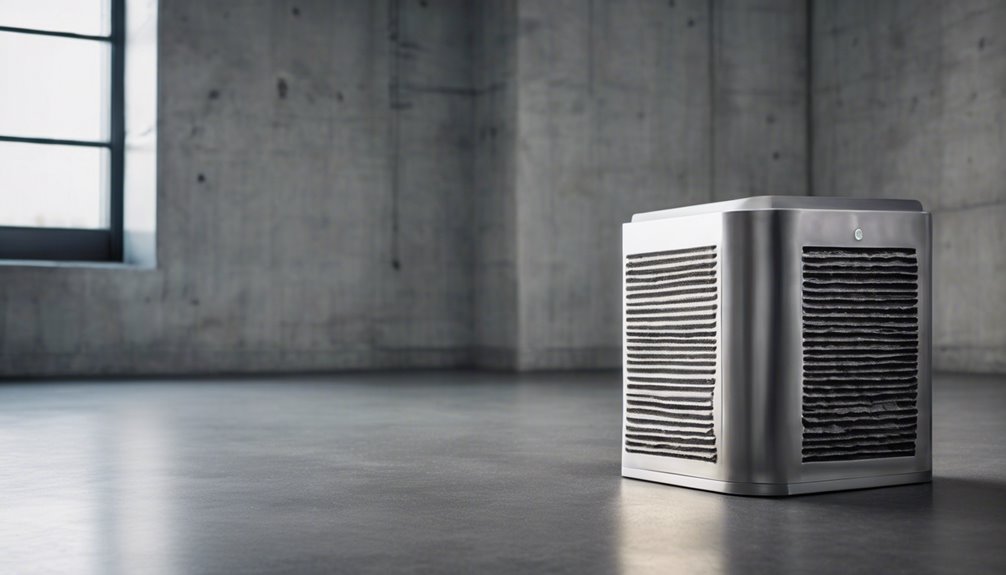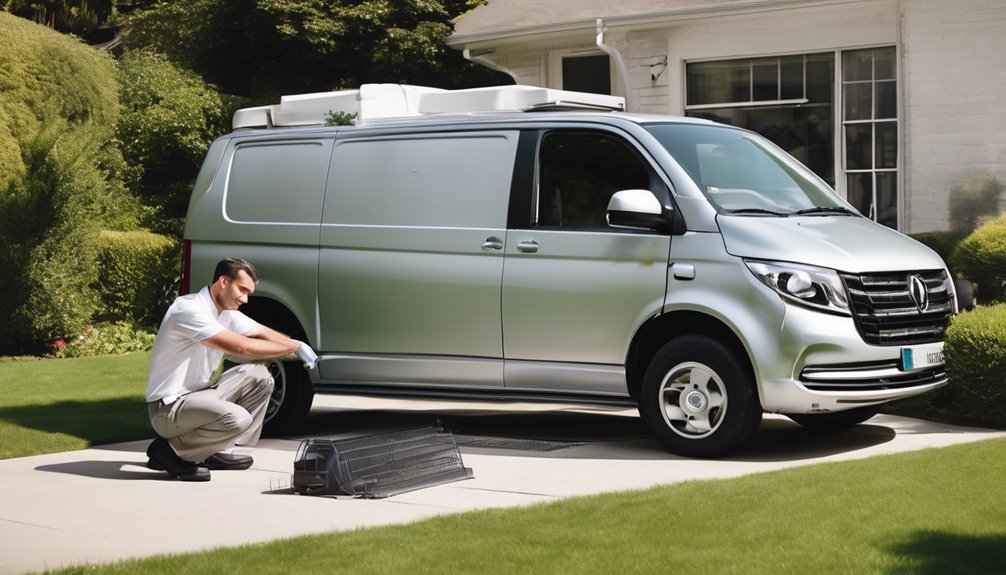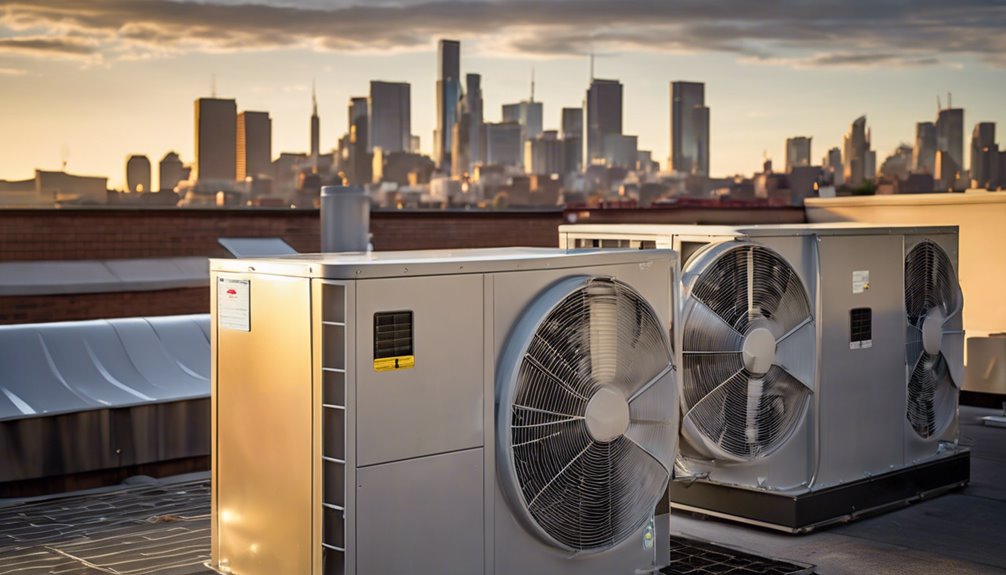You can significantly reduce annoying AC vibrations by identifying and addressing the root cause, balancing and securing the unit, replacing worn-out parts, and using effective vibration reduction methods and insulation. Start by pinpointing the source of the vibration, then check the mounting hardware, fan blades, and motor bearings for signs of wear. Secure your window or portable AC to the wall, add mass-loaded vinyl sheets or vibration-dampening mats, and consider using anti-vibration mounts or insulation materials. If you're still experiencing issues, you may want to explore further solutions to silence that pesky hum.
Key Takeaways
- Identify and analyze the vibration to determine its frequency and amplitude, and locate the source of the noise using sound diagnosis.
- Balance and secure the AC unit by checking and replacing worn-out parts, ensuring proper mounting, and leveling the unit to prevent vibrations.
- Add vibration-dampening materials, such as mass-loaded vinyl sheets or vibration-dampening mats, to reduce vibrations and prevent tipping.
- Consider using anti-vibration mounts, acoustic wraps, or thermal blankets to absorb and dissipate energy, breaking the vibration transmission path.
- If DIY approaches are ineffective, seek professional assistance from expert technicians who can provide customized solutions and advanced diagnostic services.
Identify the Source of the Vibration
When your air conditioner is humming along, the last thing you want to deal with is annoying vibrations that can rattle the entire unit and even transfer to the surrounding walls and floors.
To tackle this issue, you need to identify the source of the vibration. Start by conducting a vibration analysis to determine the frequency and amplitude of the vibration. This will help you pinpoint the root cause of the problem.
You can also use sound diagnosis to locate the source of the noise. Listen carefully to the AC unit and try to pinpoint where the vibration is coming from. Is it the compressor, fan, or perhaps the mounting system?
Balance the AC Unit
You'll need to balance your AC unit to prevent vibrations.
Start by checking the mounting hardware to ensure it's securely fastened, then inspect the fan blades for any signs of damage or unevenness.
Next, level the unit to guarantee it's sitting evenly on the floor or mounting bracket.
Check Mounting Hardware
One common culprit behind AC vibrations is improperly secured or loose mounting hardware. You should check the mounting hardware to ensure it's securely fastened and not worn out. Look for signs of rust or corrosion, which can weaken the hardware's grip.
| Hardware Type | Mounting Patterns | Rust Resistance |
|---|---|---|
| Stainless Steel | Square and Hex | High |
| Galvanized Steel | Hex and Round | Medium |
| Aluminum | Round and Oval | Low |
Check if the mounting patterns match the AC unit's design. Ensure the hardware is compatible with your AC unit's material to prevent rust and corrosion. If you find any issues, replace the hardware with new ones that fit your AC unit's specifications.
Inspect Fan Blades
The spinning fan blades of your AC unit can create a significant amount of vibration, especially if they're out of balance or damaged.
You'll need to inspect them carefully to identify any issues. Start by turning off the power to the AC unit and removing the grille or cover to access the fan blades.
Visually inspect each blade for signs of damage, such as cracks, dents, or rust. Clean the blades gently with a soft brush or cloth to remove any dirt or debris that may be contributing to the vibration.
If you find any damaged blades, consider replacing them to ensure proper balance and smooth operation.
Level the Unit
After addressing any issues with the fan blades, it's time to turn your attention to the AC unit itself.
Now, you'll need to ensure the unit is properly levelled to prevent vibrations. Check the unit foundation to make sure it's even and stable. If it's not, adjust the feet or mounting system to get it level.
This is crucial for airframe stability, as an unlevelled unit can cause the entire system to vibrate excessively. Use a spirit level to ensure the unit is perfectly horizontal.
Secure the AC to the Wall
You'll want to secure your AC to the wall to prevent it from shifting or toppling over, which can't only reduce vibrations but also ensure your safety.
This is especially important if you have a window AC or a portable AC that can easily tip over. To secure your AC, you can use wall anchors or AC stabilizers.
Secure window or portable ACs with wall anchors or AC stabilizers to prevent tipping and ensure safe operation.
Wall anchors are screwed into the wall and provide a sturdy base for your AC, while AC stabilizers are designed specifically for your AC model and provide extra support.
Make sure to follow the manufacturer's instructions when installing these devices. By securing your AC to the wall, you'll reduce the risk of accidents and minimize vibrations.
Add Vibration-Dampening Materials
Adding vibration-dampening materials between your AC and the floor or wall can significantly reduce the vibrations that travel through the building.
By placing these materials in strategic locations, you can absorb the shock and vibrations generated by your AC unit.
- Use vibration pads made of thick, heavy materials like rubber or cork to create a buffer zone.
- Install rubber mounts under the AC's feet to reduce the transmission of vibrations.
- Add mass-loaded vinyl sheets to the wall or floor to dampen the vibrations.
- Place a vibration-dampening mat under the AC unit to further reduce the vibrations.
Replace Worn-Out Parts
You'll need to inspect the mounting brackets to ensure they're securely holding the AC unit in place, as loose or worn-out brackets can cause vibrations.
Additionally, you should check the motor bearings, which can also contribute to vibrations if they're worn out or damaged. By replacing these worn-out parts, you can significantly reduce AC vibrations.
Inspect Mounting Brackets
The air conditioner's mounting brackets are responsible for keeping the unit stable and secure, but over time, they can wear out, causing vibrations.
You'll need to inspect them regularly to prevent bracket wear and mounting fatigue. Check for signs of wear, such as rust, corrosion, or loose bolts.
- Look for any cracks or breaks in the brackets themselves
- Check the bolts and screws that hold the brackets in place
- Inspect the rubber pads or grommets that absorb vibrations
- Verify that the brackets are securely attached to the AC unit and the surrounding structure
Check Motor Bearings
Worn-out motor bearings can be a significant contributor to AC vibrations, as they cause the motor to wobble and vibrate excessively.
You'll need to check your motor bearings for signs of wear and tear. Listen for unusual bearing noise, like grinding or screeching sounds, which indicate worn-out bearings.
Inspect the bearings for signs of motor wear, such as rust, corrosion, or overheating. If you find any issues, replace the bearings with new ones.
Make sure to follow the manufacturer's instructions for replacement and lubrication. Properly maintained bearings will help reduce AC vibrations and ensure your air conditioner runs smoothly and efficiently.
Check and Tighten Loose Screws
Vibrations from your AC unit can often be traced back to loose screws, which can cause the entire system to rattle and hum.
You'll need to perform a screw analysis to identify any loose screws and tighten them to stop the vibrations.
- Check screws on the compressor, fan, and condenser coils
- Look for screws that are loose or missing entirely
- Use a screwdriver to tighten any loose screws
- Consider replacing screws that are damaged or worn out
Regular screw maintenance can help prevent vibrations from occurring in the first place.
Level the AC Unit
You'll need to ensure your AC unit is properly leveled to prevent vibrations from occurring.
A level AC unit is crucial to reducing vibrations, as an uneven surface can cause the unit to wobble and vibrate excessively.
A level surface is essential to minimize vibrations, as unevenness can cause the AC unit to wobble and vibrate excessively.
Check the floor clearance around the unit to ensure it has enough space to operate efficiently.
Improper unit placement can lead to restricted airflow, which can cause vibrations.
Make sure the unit is placed on a firm, level surface, and adjust the feet or base accordingly.
Verify that the unit is stable and even, and make any necessary adjustments to prevent vibrations.
Use Anti-Vibration Mounts
Anti-vibration mounts can be a game-changer in reducing unwanted AC vibrations.
By installing these mounts, you can significantly minimize the vibrations transmitted to the surrounding structure. This is achieved through a clever mount design that absorbs and dissipates the energy, resulting in effective vibration reduction.
- The mounts work by decoupling the AC unit from the floor or wall, breaking the vibration transmission path.
- They're available in various types, including spring, rubber, and hydraulic mounts, each suited for specific applications.
- Anti-vibration mounts are easy to install and require minimal maintenance.
- They can be used in both new and existing AC installations, making them a versatile solution for vibration reduction.
Insulate the AC Unit
One effective way to reduce AC vibrations is to insulate the unit itself. By wrapping the AC unit with acoustic wraps or thermal blankets, you can significantly reduce the vibrations that are transmitted to the surrounding structure. This is especially effective for window units or portable ACs that are not mounted on anti-vibration pads.
| Insulation Material | Effectiveness | Cost |
|---|---|---|
| Acoustic Wraps | High | Moderate |
| Thermal Blankets | Medium | Low |
| Fiberglass Insulation | Low | High |
When choosing an insulation material, consider the level of vibration reduction you need and your budget. Acoustic wraps are a popular choice for their high effectiveness, but they may be more expensive. Thermal blankets offer a more affordable option, while fiberglass insulation is a more cost-effective solution, albeit with lower effectiveness.
Consider Professional Assistance
If you've tried the DIY approaches and your AC unit is still vibrating excessively, it's time to consider seeking professional assistance.
You'll benefit from expert diagnostic services that can pinpoint the root cause of the issue, drawing on specialized AC knowledge that you may not possess. A professional can develop a customized solution tailored to your specific situation, providing a more effective and efficient fix.
Expert Diagnostic Services
When AC vibrations become persistent and disruptive, it may be time to consider seeking expert diagnostic services to identify the root cause of the issue.
These professionals have the training and equipment to perform a thorough system analysis to determine what's causing the vibrations.
- They'll use advanced diagnostic tools to inspect your AC unit and its components
- They'll check for loose or worn-out parts, misaligned components, and other potential causes
- They'll analyze the AC's electrical and mechanical systems to identify any faults or malfunctions
- They'll provide you with a detailed report outlining the problem and recommending the necessary repairs
Specialized AC Knowledge
Your AC's complex system requires a deep understanding of its inner workings to accurately diagnose and fix vibration issues.
Without it, you may end up replacing the wrong parts or overlooking underlying problems, leading to continued vibrations and wasted money.
That's why it's essential to consider professional assistance from experienced technicians who possess specialized AC knowledge.
They've spent years studying and working with air conditioning systems, developing the expertise needed to identify and resolve vibration issues efficiently.
Customized Solution Development
By entrusting your AC's vibration issues to a professional, you're not just handing over the problem – you're gaining access to a customized solution developed specifically for your unique situation.
This customized approach ensures that the solution design is tailored to your AC's specific needs, taking into account its model, age, and operating conditions.
- A thorough on-site assessment to identify the root cause of the vibrations
- A detailed report outlining the recommended solution and its implementation plan
- Access to specialized tools and equipment required for the job
- Ongoing support and maintenance to ensure the solution remains effective
Frequently Asked Questions
Can I Use Rubber Bands to Dampen AC Vibrations?
You're wondering if rubber bands can dampen AC vibrations, but they're not the best solution. Instead, consider using rubber mounts or vibration isolators, which are specifically designed to absorb vibrations and provide a more effective and long-lasting solution.
Will Vibration Reduction Affect My Ac's Cooling Performance?
You're wondering if reducing vibrations will impact your AC's performance. Yes, it can; you'll face a vibration tradeoff, potentially affecting cooling efficiency. However, a slight drop in performance is often a fair trade for the convenience and quiet operation you'll gain.
Can I Fix AC Vibrations on My Own Without a Professional?
You can try DIY troubleshooting to identify vibration causes before calling a pro; check the unit's balance, loose screws, and worn-out mounts, but if unsure, it's still best to consult a professional for a thorough assessment.
How Long Does It Take to Stop AC Vibrations Completely?
You'll likely spend several hours to a few days identifying the vibration frequency and amplitude, then implementing fixes, but stopping AC vibrations completely depends on the complexity of the issue and your DIY skills.
Will Stopping AC Vibrations Reduce My Energy Bills?
You're wondering if reducing vibrations will cut your energy costs. The answer is yes! When your AC runs smoothly, it operates more efficiently, leading to significant cost savings and improved energy efficiency, which will show up on your utility bills.
Conclusion
You've finally tackled those pesky AC vibrations! By following these steps, you've identified and addressed the source of the problem, ensuring a smoother and quieter operation. Remember, regular maintenance is key to preventing vibrations from coming back. With your AC unit now running smoothly, you can enjoy a more comfortable and peaceful living space.



